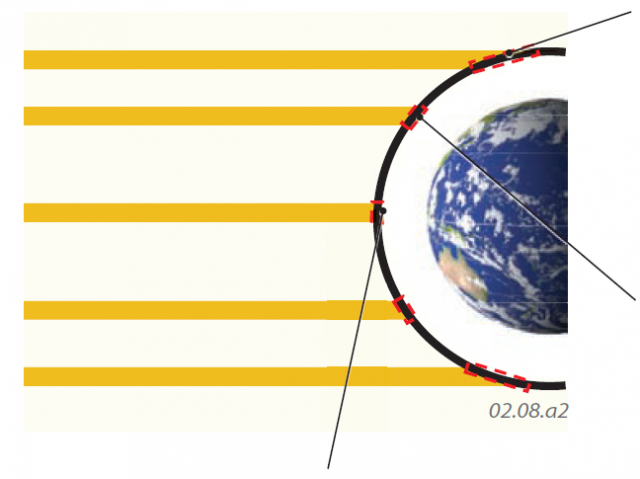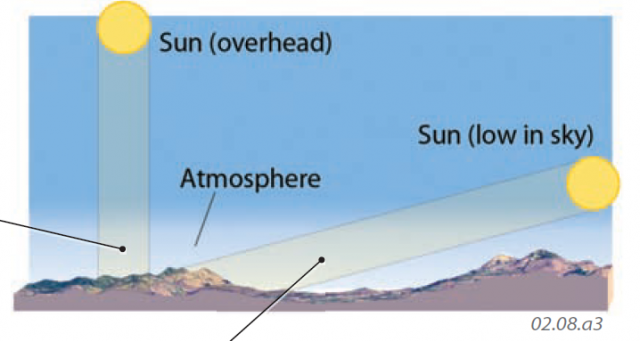Why Does Insolation Vary from Place to Place?
DESPITE A FAIRLY CONSISTENT supply of energy from the Sun, considerable differences in the quantity of insolation are experienced between the poles and equator, and also over several timescales — most noticeably, changes between seasons and between night and day. On Earth, variations in insolation are mostly related to latitude.
What Controls the Insolation Reaching the Atmosphere and Earth's Surface?
The amount of sunlight varies from time to time and from place to place. In the summer, sunlight feels more intense than it does in winter. Also, there are huge ranges in temperature between the warm, tropical regions of the world and the cold, polar regions. A main factor controlling the maximum possible amount of insolation is position on the Earth, specifically the latitude.
1. When thinking about insolation, an important aspect to consider is the orientation of energy with respect to the surface being irradiated. In the figure to the right, a flat surface is illuminated by two identical lights, each with an energy equal to the amount of solar energy striking the top of the atmosphere (345 W/m2). The left light is shining directly down on the surface, so the surface receives the same amount of energy per square meter as the light emits (345 W/m2).

2. The second light is angled 45° relative to the surface, so when its light strikes the surface the light is spread out over a larger area. As a result, the amount of energy per area is less, and the area would be less brightly lit. For an angle of 45°, the energy is spread out over an area 1.41 times longer than for the left light, so the resulting energy is less, at 244 W/m2. The angle between the direction of energy emission and the surface is called the angle of incidence and is 90° for the left light and 45° for the right one.
3. The geometric relationship shown in the previous figure applies to the entire Earth because of its spherical shape. The figure to the right shows how equal rays of solar energy strike different parts of the Earth, varying in angle of incidence from a position along the equator to ones nearer the poles. Each orange bar is of equal width and represents insolation equal to the solar constant.

4. Some insolation strikes the outside of Earth's atmosphere perpendicularly, like a light pointed directly toward a surface. This part of the atmosphere is receiving the maximum insolation possible, or an amount of energy equivalent to the solar constant, at the “top” of the atmosphere, 1,366 W/m2.
5. In the mid-latitude regions north or south of the equator, insolation strikes the outside of Earth's atmosphere at a slightly oblique angle and is distributed over a wider area than at the equator. Thus the amount of energy is distributed over a larger area compared to the equator, and the energy per area is less. The area shown (on the outside of the atmosphere) receives about 60% of the solar constant, more if the area is closer to the equator or less if it is farther away — that is, the amount of insolation varies as a function of latitude.
6. In contrast to the equator, insolation arriving above polar regions strikes Earth's atmosphere at a very low angle of incidence, much lower than the angled light in the figure above. As a result, the energy represented by the ray (the solar constant) spreads over a relatively large surface area (the small red box). Insolation striking that part of the atmosphere, as measured in energy amount per area, is considerably dispersed, diminished to perhaps only 20% of the solar constant.
7. In addition to these geometric effects, the atmosphere further influences the amount of insolation that reaches Earth's surface, depending on the angle of the incoming energy. As shown in this figure, energy that comes directly down at the surface, like a vertical light, passes through the atmosphere in the shortest distance possible. Some energy is reflected or absorbed by the atmosphere.

8. Energy coming at a lower angle of incidence must pass through more of the atmosphere to reach the surface. This increases the amount of atmospheric attenuation and causes less energy to reach the surface. This is a further reason why early morning and late afternoon sunlight does not feel as intense as that at noon, and why the winter Sun, which is low in the sky, does not feel as intense as the summer Sun, which is higher in the sky.
9. When viewing the entire Earth, latitude strongly influences the severity of atmospheric attenuation. Near the equator at noon, the Sun's energy is coming at a high angle of incidence, and experiences relatively less attenuation.

10. In the mid-latitudes, the energy is more oblique to the Earth, so must pass through more of the atmosphere. This results in more atmospheric attenuation, resulting in less energy reaching Earth's surface.
11. In polar and high-latitude regions, the angle of incidence is very low, and the Sun's energy must pass through even more of the atmosphere. The amount of atmospheric attenuation is greater, so less energy passes through to the surface.
What Is the Zenith Angle and How Does It Affect Insolation?
1. The angle made by two lines, one drawn from the observer to the Sun at its position and the other drawn directly over the observer's head, is called the zenith angle. Note that the zenith angle is measured from vertical, regardless of the slope of the land. When the shadow of an object is directly underneath the object, the zenith angle is 0°.

2. This figure shows the Sun at four different positions, corresponding to four different zenith angles (at noon). The 10 thin orange rays of sunlight represent equal amounts of energy (the solar constant). The brackets on the ground indicate the width over which that same amount of sunlight strikes the surface.
3. In this example, if the zenith angle is 0°, as happens near the equator and in the tropics, the 10 rays of sunlight intersect the Earth's surface over a width of 10 meters. The light is perpendicular to the surface, so the area receives the maximum amount (100%) of energy possible.

4. In a subtropical latitude, with a zenith angle of 30°, the 10 rays of sunlight are spread out over a wider area, so the surface receives less insolation per square meter compared to a site at the equator, but not much less (87%).
5. If the zenith angle is larger, like 60° in a high-latitude location, the 10 rays of sunlight are spread out over 20 m (twice the area as at the equator), so any area receives only 50% of the sunlight per square meter that the equator does.
6. For a location directly at Earth's North or South Pole (the Sun position on the far right), the zenith angle can be 90°, and none of the 10 rays of sunlight hit the ground. Brrrrrrrrrrrrrrr!
How Does Insolation Vary by Time and Location on Earth's Surface?
The amount of sunlight that reaches the surface varies greatly with latitude, due to the reinforcing effects of zenith angle and atmospheric attenuation. These variations in insolation result in huge ranges in temperature between the warm, tropical regions of the world and the cold, polar regions.
The least variation in insolation through the year occurs in equatorial regions, which do not experience summer versus winter. The length of daylight in equatorial regions is always around 12 hours, and zenith angles (at noon) are always small. The Sun is directly overhead in March and September and nearly so the rest of the year, so temperatures remain warm throughout most of the year.
Polar regions experience the maximum variation in insolation. During the summer this region has 24 hours of sunlight, allowing fully lit outdoor excursions, but during the winter there is no sunlight. Even during the summer, large zenith angles prevent insolation from increasing too much. The combination of months of darkness and low insolation causes polar areas to have very cold average temperatures.
Areas between the tropical and polar regions, such as those in the mid-latitudes, experience an intermediate amount of variability in insolation and so typically have distinct seasons. The mid-latitudes have some sunlight and darkness every day, with longer days and lower zenith angles during the relatively warm summer. The winter has shorter days and larger zenith angles, so it is colder than the summer.